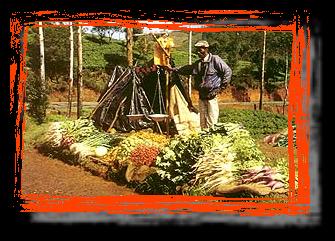
|
From the Garden
to the Table?
How fresh do you like your
Pathola, Karawila, Boanchi,
and Brinjals (snake gourd,
bitter melon, beans and egg plants) today?. Like to pick it yourself straight
from this small farmers back yard?. Due to a short lived, but
highly effective import
embargo in the 70's of some
essential products, including
some food items, the
average Sri Lankan turned
to farming and even after the embargo was lifted kept his green thumbs
intact and
working hard. Now-a-days
scenes like these, where
villagers are selling common
every day vegetables, like beans and egg plants and more exotic fruits
like Mangosteen, Durian and Rambotan, are unavoidable
for the visitor to the countryside.
|
|
Looking for
a Fresh Catch?
A typical morning scene on
the Western and
Southern coasts. Fishing
is still done mostly by
oruwa canoe-like
out-rigger boats like these, but now
small motorized boats are
beginning to replace these ancient crafts. People in Sri Lanka have been
using
oruwas like these
for centuries and the evolution
goes back to pre-historic
times.
The days catch like, tuna
and seer, crabs and
prawns (shrimp) are sold
right off the boat at the
beach, to the highest bidder,
with one small
caveat. Haggling with the
fishermen for the price of
fish could be harmful to
your well being !! -
they are notoriously short
tempered, and Oh !! the
language if you cross them
!! .
|
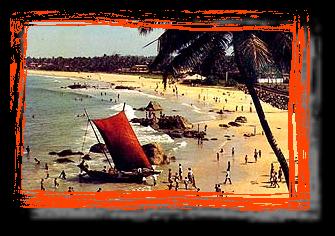
|
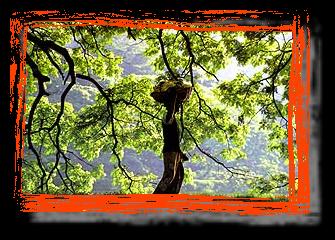
|
Up in the Hills:
If you have ever been in
the central highlands of
Sri Lanka, this is a scene
that you will see repeated
all over. A small trail,
up in the hills, with morning
mist rising in the valley
around you, the lush
greenery wet with condensing
dew from the cool night -
The local small trader (watti
amma - an endearing
term used to describe door-to-door
produce
saleswomen) making her way
to the local pola (farm market), her woven basket filled with fresh picked
vegetables and fruit balanced
on her head - If you
listen very carefully, you
have to listen very
carefully, for there are
other distracting sounds,
like the bubbling of water
in a nearby brook, or the
various nestlings waking
up to the rising sun and c
rying out for the first
bite of the day, you just might
be able to hear the gentle
laughter of children on
their way to school.
|
|
Doormats for
Sale ..
It is believed that no part,
except for the root ball,
of the coconut tree is unused.
Starting from the bottom,
the steel-like wood from
the trunk makes unique and long-lasting furniture. The fruit , when young,
provides a
fresh drink somewhat akin
to champagne when
chilled, and a potent drink
(ra)
when
fermented
over-night. Distilled, this
makes arak, the local
equivalent of whiskey. The
fresh fruit provides coconut
milk for cooking, and the
shell, charcoal. In the
villages where throwaway
paper cups are
unheard of, a cleaned coconut
shell makes
temporary cup for that all
important cup of tea.
The woven leaves, make ideal
thatching for the roof,
for it allows for the (cooking)
smoke etc. to escape
while keeping the heaviest
of downpours at bay. The
items shown here is a small
sample of the many products that are manufactured from coconut fiber
(coir)
|
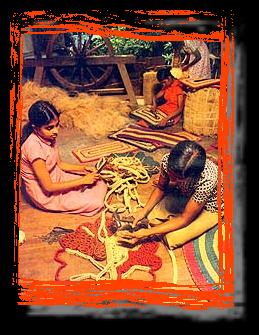
|
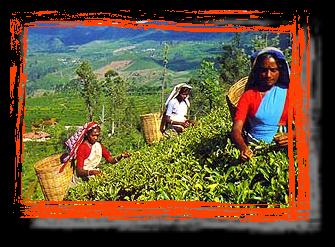
|
A Tea Estate
in the Hill Country
For most Sri Lankans like
many other foreigners, living
away from home, the most
frequently asked question
seems to be " Where are
you from ?". If the obvious
answer is given, many-a-times
the reaction is "Ah,
Ceylon - where the tea comes
from". Of course many
of us go to the trouble
of explaining, that the name
now is Sri Lanka. Small
incidents like this shows how closely tea is tied to Sri Lanka.
Tea, introduced to Sri Lanka
(then Ceylon) by the
British in 1849, is still
one of the main export products. Today tea is grown in three distinct elevation
levels. Low-grown from sea level to 2,000 feet, Mid-grown from 2,000 to
4,000 feet, and high-grown 4,000 feet and
higher. Teas grown in various
part of the country have
their own distinctive flavors
and aromas, somewhat analogous to vine grapes. An expert tea taster, like
a
good vine taster, can differentiate
between teas from
different regions, and even
between different
estates in the same region.
|
|
A Village Market
This is a picture of a typical,
pola
- country market,
that can be found anywhere
in Sri Lanka. Although
mom and pop groceries, and
supermarkets are making strong inroads, the village
pola still holds
a nostalgic
foothold in the Sri Lankan
life. Here, the busy house-wife
on her way back home in
the evening from her job in the office, can still get her fresh coconut
for the evening
meal, without having to
stand in line to pay for it. And
if you just don't happen
to have the cash to pay for it
today, it is alright too.
Not to worry !. You will be
there tomorrow too - it
is almost a family affair!.
|
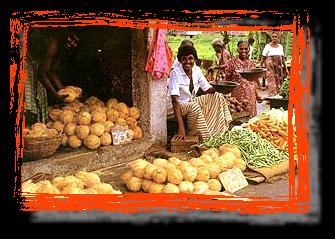
|
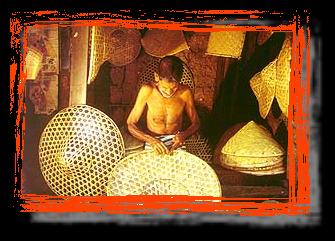
|
Sun Hats for
Sale !!
I another part of the pola
- The forgotten art of weaving?.
Well not quite. This old
craftsman certainly seems to
have a lot of fun doing
what he is good at. And who wouldn't?. Imagine all the pretty young things
in their
swim suits, coming to him
on their way to beach, for
sun hats. Some of these
hats are made out of fresh
young palm fronds and they
last only the day.
Talking about a good customer
base !.
Some of the larger markets
are a jumble of sights,
smells and sounds, and well
worth a visit. At the
polas (markets) bargaining
or haggling is almost
expected of the buyer and
if you are good at it you 'll
walk away feeling that you
got a good bargain - or
did you really ?.
|
|
Hot Peppers
Drying in the Sun
The dry northern plains of
Sri Lanka is blessed with
ideal climate for growing
may varieties of crops.
The hot day-time temperatures
and dry air make it
specially suitable for vegetables
like chilli (hot pepper)
and onions. Looks like the
owner of this small farm
certainly had his share
of good luck with his crop,
looking at this red carpet
of chilli peppers drying in the hot sun. The small home in the background
is made
totally from locally available
building materials. The
adobe walls, and the roof
made of woven coconut
fronds bear witness to the
ingenuity of the
simple village folk.
|
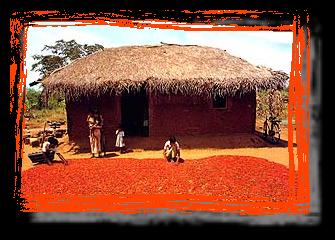
|
|
